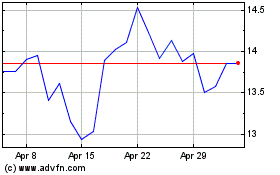Delta Surpasses United for No. 2 Airline Spot by Traffic
January 12 2016 - 3:00PM
Dow Jones News
Delta Air Lines Inc. nosed ahead of United Continental Holdings
Inc. in 2015 to become the nation's No. 2 airline based on newly
released traffic figures for the year, adding a flourish to the
Atlanta-based carrier's strong performance in recent years.
Delta said it ended the year with 209.6 billion miles flown by
paying passengers, up 3.3% from the prior year. That put it behind
American Airlines Group Inc., which on Tuesday reported its traffic
rose 2.4% to 223 billion revenue-passenger miles in 2015. United
came in at 208.6 billion revenue-passenger miles, up 1.5% from
2014. The figures include regional-carrier partners flying under
the airlines' brands.
United has been one of the most cautious carriers about boosting
its capacity in recent years, and has been consumed with trying to
finish integrating its operations and workforce after its 2010
merger. United said it is "continuing to focus on running a
reliable operation and investing in the tools and services that
allow us to deliver the flier-friendly experience our customers
deserve and expect." Delta declined to comment on its higher
ranking.
Traffic—the number of passengers multiplied by the miles they
flew—is widely used to compare airlines. Rankings differ slightly
by other measures, such as the number of passengers carried:
American hauled 201.2 million fliers last year, Delta 179.4
million, Southwest 144.6 million and United 140.4 million. Based on
annual revenue, Delta had already been second after American before
last year, and by market capitalization, Delta ranks first, with a
value of about $37 billion, followed by Southwest Airlines Co. at
$27 billion.
Traffic volume doesn't necessarily translate into profit,
although all the U.S. carriers for now are posting record results
on sharply lower fuel expenses, conservative capacity additions and
a gush of revenue from charging for things such as checked luggage,
priority boarding, Wi-Fi service and food.
Delta had become first by traffic among U.S. airlines after its
2008 merger with Northwest Airlines. But it lost that crown in 2010
when United bolstered its size by merging with Continental
Airlines. American, after its combination with US Airways in late
2013, retook the top honors in 2014.
Southwest, the nation's largest discounter, has long cruised in
fourth place, despite its 2011 acquisition of AirTran Airways. It
has no regional partners. Last year, Southwest racked up 117.5
billion revenue-passenger miles, up 8.8%.
The four largest U.S. carriers control more than 80% of domestic
capacity because of the recent mergers. The three biggest also have
extensive international operations, with United leading the
pack.
The rest of the U.S. airlines are much smaller, with JetBlue
Airways Corp. and Alaska Airlines Group Inc., generally the largest
of that group by traffic. Smaller still are Hawaiian Holdings Inc.,
Virgin America Inc., Spirit Airlines Inc., Frontier Airlines and
Allegiant Travel Co.
Write to Susan Carey at susan.carey@wsj.com
(END) Dow Jones Newswires
January 12, 2016 14:45 ET (19:45 GMT)
Copyright (c) 2016 Dow Jones & Company, Inc.
American Airlines (NASDAQ:AAL)
Historical Stock Chart
From Mar 2024 to Apr 2024

American Airlines (NASDAQ:AAL)
Historical Stock Chart
From Apr 2023 to Apr 2024
